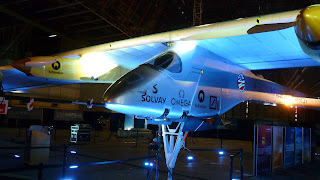The world is turning
It wasn’t press night
but she could still be late home. Sometimes the Weekly News would send
her off on some errand that might not turn up a story at all and she would
clatter into the flat at seven or eight in a scratchy, liverish temper and the
food he’d kept warm would not be well received. Tonight the downstairs door
slammed way past dinnertime and she came up the stairs with more than usual
vigour. It’s going to be one of those nights, he thought, and wished it wasn’t
as he’d spent his day repairing the inlet manifold on a Vauxhall Corsa that should
have been laid to rest three or four MoTs ago. Sometimes he hated having his
own workshop, taking as he did every job for fear of missing income.
 |
| M.Robbins |
“Is that you?” he called.
“No, it’s Putin, you pillock.”
“Oh.” He went on
looking at the screen. “I should’ve made borscht then. Next time.”
“You could at least
turn the volume down when I come in.”
“Sorry. Third Test
from Headingley. They’re following on.” He looked round. “Shall I peel you a
grape, dear?”
“Perhaps you’d better.”
She slumped down on the sofa. “I had to go to Market Sinking.”
“You mean Market
Deeping,” he said.
“No, it’s sunk. It’s
like Wisbech but worse. Anyway, I went to interview this old engineer bloke in
a care home, he’s a hundred.” She flipped through her notebook. “Had to get his
life story. Didn’t understand half of it. I asked how he started off and he
said” – she looked at her notes – “in 1938 he was apprenticed at 14 to King’s
Lynn Shed, whatever that was, cleaning B12s, whatever they were. Then in the
war he was servicing Beaufighters in the western desert, whatever and where
that means. Then he mentioned something called sleeve valves which were jolly
awkward.”
“The B12 was a steam
engine in the eastern region that used to haul trains to Liverpool Street, back
then,” he replied. “The Beaufighter was an aeroplane. Its engines had sleeve
valves, which go round and round instead of up and down.”
“That’s illuminating,”
she said.
He looked at her and
sensed an unusual mood. “I fancy a Broadside if you do,” he said.
“I would love a
Broadside.” She kicked off her boots, sat back and watched as he went to the
fridge and opened two bottles of beer. “He said something that made me think
about you,” she called. “About the workshop. He said guys won’t work on engines
and things the way he did, soon.”
He handed her a
bottle. “No,” he said. “We won’t.”
She looked up. ”You say that too?”
“Oh yes. I should
never have bought the workshop. What did he say exactly, anyway?”
“That everything’s
evolving. Hang on, I’ve got the quote here.” Like most young journalists now, she
knew no shorthand; but she took out her recorder and wound back the file.
“Listen to this.” And he heard her voice say: “How have things changed over the
years?” She had kicked herself as she said it; it had seemed so trite. But his
voice answered clearly enough, if a little quavery.
“Young lady, tell me
how you will start your car when you leave here.”
“Oh. Well, I shan’t,”
she said. “They key is in my pocket and it talks to the car. As I come up to it
the door handle will come flip out and when I get in and touch the brake, all
the systems will turn on.”
The old man looked
back at her, smiling, one of his eyes watering a little. ”Now, my first car, I
went out and started it with a starting-handle,” he said. “There was a
self-starter, but it never worked.” He thought for a minute. “If that car was
still with us it’d be 105 years old.”
She laughed.
“Thing is, your car
now, it doesn’t even have an engine, does it?” said the old man’s voice. “Just
an electric motor. And that’s as it should be. Think about an engine. Each
piston begins its cycle by sucking in fuel on a downward stroke, compressing it
on the upward stroke, being driven down by combustion on the next stroke and
then expelling the waste gases on its exhaust stroke. With four such pistons,
there are one hell of a lot of moving surfaces, all going in different
directions at any one time. So the cylinders that are moving a large surface
area that constantly changes direction, meaning that it must also accelerate
and decelerate a great deal of mass. And there are belts or chains from the
crankshaft will drive the shafts that open and close the valves at the top of
the cylinders, and will also turn the water pump that cools the engine and will
drive the alternator.”
“Gosh,” she said on
the tape.
“Now, let me tell
you,” the old man went on. “Good engineering gets simpler. Not more complicated.
But petrol cars are very complicated. The most modern of petrol cars is a
demented Heath Robinson device that flies in the face of physics. An
incompetent child might make one with a Meccano set.” He paused briefly again,
then said: “Things evolve, see? They change. They’re changing now.”
“If you were still a
mechanic, would you stay one today?” she asked.
“Bless you, no,” he
said, and she remembered his smile. Then he had fallen asleep.
She stopped the
playback and looked at her partner. He nodded.
“I wanted my own
workshop so badly,” he said.
“I know.” She took a
gulp of beer. ”But the world is changing, isn’t it? We got to change with it. I
will, too. The Weekly News is nearly dead. People post their own news
online now.”
“I guess we’d better
evolve then,” he said. They were silent for a few minutes, then he glanced at
the screen; he’d muted it. “Been a crap season for England,” he said.
“Well some things
don’t change, do they.”
He laughed, then
frowned. “I’ll sell the workshop,” he said. “We’ll do some thinking, you and I.
We’ll be all right.”
“’Course we will.”
He didn’t turn the
sound back up; instead they sat there in the quiet as it grew dark. They felt oddly
happy.
More flash fiction from Mike







